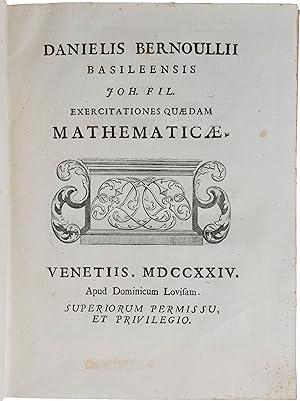About this Item
DANIEL BERNOULLI IN ITALY - FOUR WORKS BY HIM, HIS FRIENDS, AND HIS ADVERSARIES. Sammelband of four very rare works, all first editions, representing the work of the great Swiss mathematician Daniel Bernoulli, and of those of his friends and adversaries, during the period 1723-25 he spent in Italy. Bernoulli s Exercitationes is his first mathematical publication, the success of which resulted in his appointment to the Academy of Sciences in St Petersburg. The work is in four parts, and is notably polemical. In the first part Bernoulli develops the theory of recurrent series and applies it to problems of probability involving the card game Faro; here Bernoulli disputes the position of Giovanni Rizzetti, famed as a critic of Newton s theory of light. This was "evidence of his early interest in the work on the theory of probability done by his predecessors Montmort and De Moivre, which had been nourished by discussions with his cousin Nikolaus I" (DSB). In the second part, Bernoulli addresses the hydrodynamic problem of the outflow of water through a hole at the bottom of a vessel. Bernoulli supports the opinions of Pietro Antonio Michelotti; it was to study medicine under Michelotti that Bernoulli travelled to Venice in 1723, and Bernoulli s interest in this problem was probably motivated by his study of blood flow and blood pressure. Opposing Jacopo Riccati, Bernoulli supports the (erroneous) theory put forth by Newton in the first edition of the Principia. In the second edition, Newton revised his opinion and accepted Riccati s theory as correct, and Bernoulli himself revised his position in his Hydrodynamica (1738). The third part of the Exercitationes is a response to, and solution of, Riccati s work on the differential equations named after him: Bernoulli identifies the equations for which separation of variables occurs, in which case finding the solution is reduced to an integration. While in Venice, Bernoulli had proposed to Riccati s pupil Guiseppe Suzzi the problem of the quadrature of lunulae (figures bounded by two circular arcs). In the fourth part of the Exercitationes, Bernoulli takes issue with Suzzi, giving his own treatment of the problem; Suzzi published his own results the next year in Disquisitiones mathematicae, "the first Italian treatise where some currency was given to evanescent quantities and fluent and fluxions " (Guicciardini, p. 291). Daniel Bernoulli s father Johann, and uncle Jakob, were notorious for their academic disputes, but the Exercitationes was Daniel s only polemical writing. Later he developed "an aversion to all controversies" (Werke I, p. 238). Ripa s Miscellanea is a collection of four works, the most important of which is a determination of the ballistic curve , the path followed by a projectile moving under gravity in a resistive medium. Michelotti s Apologia is a defence of Johann Bernoulli s doctoral thesis De motu musculorum against the attacks of Newton s friend and personal physician Richard Mead. ABPC/RBH list only the Macclesfield copy of the Bernoulli (Sotheby s 2004, £5,400), and no copies of any of the other three works. Daniel Bernoulli (1700-82) was the most distinguished member of the second generation of the Bernoulli family, the son of Johann I. Daniel gained his baccalaureate in 1715 and master's degree in 1716 at Basle University, but, while studying philosophy at Basle, he began learning about the calculus from his father and his older brother Nikolas. He studied medicine at Heidelberg in 1718, Strasbourg in 1719, and then returned to Basle in 1720 to complete his doctorate. After completing his medical studies in 1721, he applied for a chair at Basel, but like his father before him, he lost out in a lottery. Having failed to obtain an academic post, Daniel went to Venice to study practical medicine under Michelotti (1673-1740). While in Venice he continued his mathematical studies, and made the acquaintance of Christian Goldbach (1690-1764), who assisted him.
Seller Inventory # 5535
Contact seller
Report this item




